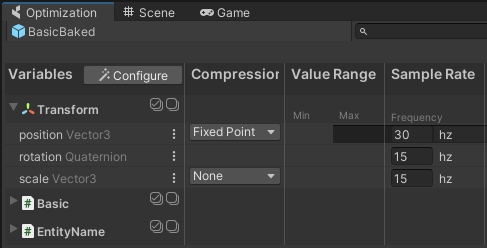Simulation Frequency
Without a special configuration, Entity data is captured at the highest possible frequency and sent to the Replication Server. This often generates more data than is needed to efficiently replicate the Entity's state across the network.
Global simulator frequency
On a Simulator, we can limit the framerate globally using Unity's built-in static variable targetFrameRate.
Application.targetFrameRate = 10;Per-binding sampling frequency
Replication frequency can be configured for each binding individually in the Prefab Optimize window. The Sample Rate controls how many times per second values are sampled and synced over the network.

High sample rates increase replication accuracy and reduce latency, but consume more bandwidth. The upper limit at which samples can be quantized is 60hz, so sample rates beyond that are generally not recommended. It is not possible to change sampling frequency at runtime.
Was this helpful?

